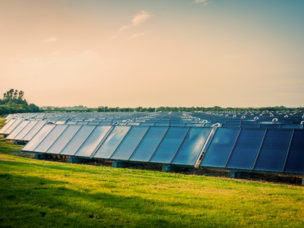Stay in the know
Subscribe to the Real Estate Blog and we’ll send you an email each time something new is posted.
Subscribe to the Real Estate Blog and we’ll send you an email each time something new is posted.
Blogs
Real Estate Blog
Solar Spotlight: The Good, the Bad and the Unknown
Those involved in the solar energy industry raised a glass during their holiday parties to toast the passage of the tax extenders bill on December 18, 2015, providing the platform for continued growth in the solar industry. As part of a compromise to lift the ban on U.S. exports of crude oil, the renewable energy investment tax credit (ITC) was extended, instead of phasing down from 30% to 10% for projects placed in service after December 31, 2016. The ITC is now subject to a 5 year incremental step down based on a project’s construction commencement date as follows:
- In 2017 through 2019, the 30% ITC remains in place
- In 2020, the ITC drops to 26%
- In 2021, the ITC drops to 22%
- In 2022, the ITC drops to and remains at 10%
The ITC extension now provides a level of certainty to the industry by establishing this known quantity in evaluating the economic feasibility of a project.
The ITC extension was passed on the heels of President Obama’s release of the Clean Power Plan (CPP) in August demanding the reduction in carbon emissions, which effectively increases the demand for other renewable energy sources, such as solar. Each state is to submit compliance plans by this summer, outlining its method for reducing carbon emissions for implementation by the summer of 2020. The ITC incentive coupled with a new federal mandate to increase renewal energy is expected to further spark the levels of growth in the solar market. As of March 1, 2016, the U.S Energy Information Administration anticipates utility scaled ground mounted solar projects to provide the most new generation capacity in 2016 at approximately 9.5 Gigawatts (DC), excluding rooftop facilities.
As a result of the December 2015, Paris Agreement on climate change, in part persuaded by the commitments in the CPP, there is a unity across the globe to reduce carbon emissions and accelerate climate action, which will fuel continued opportunity and progress in renewable energy. Solar facilities will continue to play a substantial role in this shift causing further evolution by decreasing costs, improving technology and eventually, creating energy storage in addition to distribution.
Now for some bad news. In February, the CPP was stayed by the Supreme Court, despite any prior federal appellate court review. The appeal was brought by more than half the states, several corporations and industry groups to block the implementation of the CPP. The 5-4 Supreme Court decision to grant the emergency stay included the affirmative vote of the now deceased Justice Scalia. Given the current “almost anything can happen and does” political climate in the race for the White House, whether the current or next administration appoints the next Supreme Court Justice is unknown, leaving the status of the CPP in the abyss.
In the Commonwealth of Massachusetts, the robust solar industry has been halted by its own success. In the spring of 2015, net metering capacity in National Grid’s territory was reached. As of March 10, 2016, there is also a waiting list for private net metering capacity in Unitil’s territory. In November 2015, there was a ray of hope when the House passed a bill to increase the net metering caps by 2%, but the House and Senate could not agree on a final bill. Historically, when the net metering caps have been hit, the legislature has passed a bill providing incremental relief, so projects can move forward. This legislature seems to be considering the inclusion of any net metering capacity expansion into a comprehensive omnibus energy bill (which also covers hydro power and natural gas). Although a long term fix to net metering capacity is recognized, there is real pressure to provide temporary relief now as some projects have been stalled for almost a year.
To further darken the Massachusetts solar landscape, the current Solar Carve-out II (SREC II) program has also hit capacity, despite being expanded by the Patrick administration to achieve a goal of 1600 MegaWatts (MW). On January 4th, the SREC II program reached 60% capacity triggering the Department of Energy Resources (DOER) to set aside 120 MW of capacity for small scale systems, meaning 25 kilowatts or less (Small Generation Units). The set aside caused a flood of Statement of Qualification Applications (SQA) to DOER for larger commercial sized projects. According to the DOER website as of February 19th, the SREC II program has 67.3 MW of capacity available for Small Generation Units but commercial scale, Large Generation Units are oversubscribed by 325 MW. Once a project receives an Assurance of Qualification, there is an initial 9 month reservation period (with very limited circumstances for a brief extension) for the SREC II program while the project is under construction. As SQAs are either rejected and not cured within the required time frame, or projects are not built within the reservation period, some capacity may become available. The waiting list is ordered by SQA filing date, with the Interconnection Services Agreement execution date serving as a tie breaker. With both Large Generation Unit SREC II capacity and the net metering capacity in certain territories at the limit and beyond, the Massachusetts solar market is at a crucial standstill during what should be a robust construction season.
On February 5th, DOER posted a Request for Quote (RFQ), for assistance with Post-1600 MW Solar Policy Development Technical Support with an anticipated project completion date of April 18, 2016. The scope of work includes a cost analysis over certain periods of time for ground mounted solar installations in the Commonwealth, among 4 different size categories, and covering the following types: Community Shared; Low Income; Canopies; Rooftop; Landfill; and Brownfield. The two tasks of the RFQ are: (1) to determine the incentive value needed to make solar projects feasible; and (2) to provide a comparative evaluation of direct ratepayer costs among either continuing the SREC II program, enacting a competitive solicitation process for projects over 1MW, or implementing a declining block tariff (which was previously introduced as an alternative to SREC II). This RFQ provides a glimpse into the future of solar in Massachusetts.
The long term forecast for the solar industry remains bright, but there are some storm clouds on the horizon which cannot be ignored. Particularly, the Massachusetts legislature and the DOER need to implement immediate relief to both net metering and the SREC II program to allow continued growth, progress and opportunity, while the next generation of solar incentives are thoughtfully and carefully explored. Nationally, the outcome of the CPP hinges on many factors, some beyond the control of a voter. The ITC extension sets a clear path for the industry to continue its explosive trend, especially in those states already committed to producing renewable energy and reducing carbon emissions, leaving one with a cautious but sunny outlook for the future.



